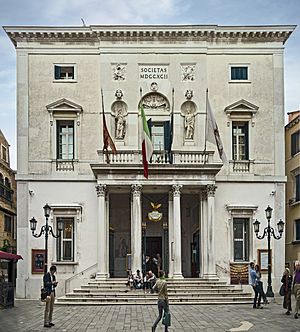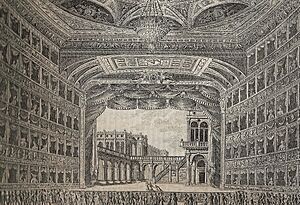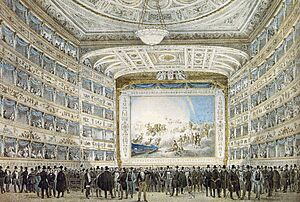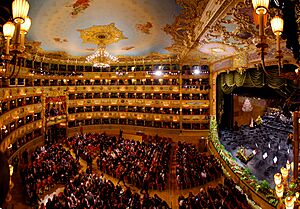La Fenice facts for kids
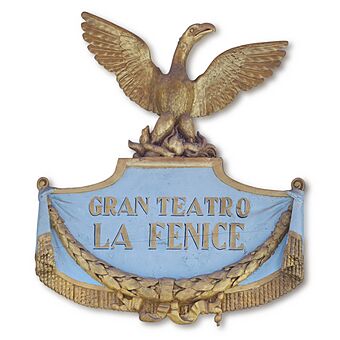 |
|
| Address | Venice Italy |
|---|---|
| Coordinates | 45°26′01″N 12°20′02″E / 45.4337°N 12.3339°E |
| Owner | City of Venice |
| Capacity | 1126 |
| Construction | |
| Opened | 1792 |
| Reopened |
|
| Architect |
|
Teatro La Fenice (which means "The Phoenix Theatre") is a famous opera house in Venice, Italy. It's known as one of the most important places in the history of Italian theatre and opera. Many famous operas by composers like Rossini, Bellini, Donizetti, and Verdi had their first performances here, especially in the 1800s.
The name "Phoenix" is very fitting because the theatre has been destroyed by fire three times and rebuilt each time! The first fire happened in 1774, but the new theatre didn't open until 1792. The second fire was in 1836, but it was rebuilt in just one year. The third fire, caused by arson, destroyed it in 1996. It was rebuilt again and reopened in November 2004. To celebrate this, the tradition of the Venice New Year's Concert began.
Contents
History of La Fenice Theatre
At the end of the 1700s, Venice had seven active theatres. The biggest one was the Teatro San Benedetto. It was built in 1755 by the Grimani family. Later, a group of box-holders (people who owned private boxes) took it over.
However, in 1787, they lost the theatre to the Venier family. This group of box-holders decided to build a new, even grander opera house. They wanted it to show their ability to "rise again" after losing their old theatre. That's why they named it La Fenice, after the mythical bird that rises from its own ashes.
They bought land in 1790 and tore down the houses there. A competition was held to design the new opera house. The design by architect Gianantonio Selva was chosen. Building started in 1791 and was finished quickly, in April 1792.
La Fenice quickly became a leading opera house in Italy and Europe. It was known for its beautiful building and high-quality performances. But, just like its name, it faced challenges. On December 13, 1836, a fire destroyed most of the opera house. Only the entrance hall and the Sale Apollinee (Apollo Rooms) were saved.
The box-holders decided to rebuild it right away. They hired the architect Giambattista Meduna and his brother Tommaso. The work began in February 1837. Performances were held in another theatre while La Fenice was rebuilt.
The new opera house opened on December 26, 1837, less than a year after the fire. It was rebuilt in the new artistic style of that time. In 1854, more restoration work was done, and the interior style remained the same until 1996. In 1935, the theatre became public property, owned by the City of Venice.
On January 29, 1996, another fire completely destroyed the theatre. This fire was caused by arson. Once again, La Fenice rose from its ashes. It was rebuilt exactly as it was before, following plans by architect Aldo Rossi. The theatre reopened on December 14, 2003.
The First Theatre's Design
In 1774, the Teatro San Benedetto, Venice's main opera house, burned down. By 1789, wealthy opera lovers wanted a spectacular new theatre. They held a competition to find an architect. Gianantonio Selva won with his design for a neoclassical building. It had 170 identical boxes arranged in a traditional horseshoe shape. This style had been popular in Venice since 1642.
The theatre was built facing a small plaza on one side and a canal on the other. This allowed for a direct entrance to the backstage area. Construction began in June 1790 and was finished by May 1792. It was named "La Fenice" to symbolize the company's survival and rebirth. La Fenice opened on May 16, 1792, with an opera called I giuochi d'Agrigento.
In the early 1800s, La Fenice became famous across Europe. Rossini's operas Tancredi (1813) and Semiramide (1823) premiered here. Two of Bellini's operas, I Capuleti e i Montecchi (1830) and Beatrice di Tenda (1833), also had their first performances at La Fenice.
The Second Theatre's Rebirth
In December 1836, fire struck again, destroying the theatre. But it was quickly rebuilt by the architect-engineer brothers Tommaso and Giovanni Battista Meduna. The new interior featured luxurious gold decorations and stucco. La Fenice reopened on December 26, 1837.
Giuseppe Verdi began his connection with La Fenice in 1844 with the first performance of Ernani. Over the next 13 years, many of his famous operas, including Attila, Rigoletto, La traviata, and Simon Boccanegra, premiered at this theatre.
During World War I, La Fenice was closed. After the war, it reopened and became a very active place, attracting many great singers and conductors. In 1930, the Venice Biennale started the First International Festival of Contemporary Music here. This brought composers like Stravinsky and Britten to write music for La Fenice.
On January 29, 1996, La Fenice was completely destroyed by fire again. This fire was caused by arson. Two electricians were found guilty of setting the fire because their company faced fines for delays in repair work.
The Present Theatre
After some delays, reconstruction began in 2001. In just 650 days, a team of 200 skilled workers rebuilt the theatre. They recreated the look and feel of the old theatre, costing about €90 million. The seating capacity was also increased from 840 to 1000.
La Fenice was rebuilt in the 19th-century style, based on designs by architect Aldo Rossi. He even used still photos from the film Senso (1954), which was filmed in the old theatre, to get details right. La Fenice reopened on December 14, 2003, with a concert featuring music by Beethoven, Wagner, and Stravinsky. The first full opera performance, La traviata, took place in November 2004.
Some critics had mixed feelings about the rebuilt theatre. Some liked the sound and found the colors bright but good. Others felt the acoustics lacked depth and the colors were too bright, calling it "a fake imitation of the past."
New Spaces in the Theatre
The motto for rebuilding La Fenice was "as it was, where it was." This meant the theatre should look exactly as it did before the 1996 fire, especially in its historic and artistic areas.
However, this rule only applied to the most important parts. This allowed for new areas of the building to be redesigned. As a result, three new rooms were created, making the theatre even more modern and functional.
La Fenice in Stories
The first book in Donna Leon's detective series, Death at La Fenice (1992), is set in the opera house. The story is about a famous orchestra conductor who dies during a performance of La traviata. The book describes the opera house in great detail as it was before the 1996 fire.
See also
 In Spanish: La Fenice para niños
In Spanish: La Fenice para niños
- Opera houses and theatres of Venice
Images for kids


